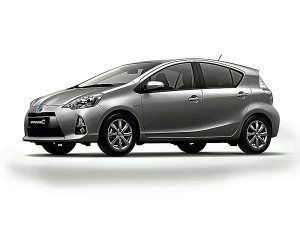Funkier Prius is here, and it’s more affordable!

THE DEPARTMENT of Tourism would love to parade this cute animal around. Why? Because it’s more fun to drive than the bigger Prius.
It’s quite ironic that the price of being an Earth-friendly, fuel-miser motorist in the Philippines still isn’t at the down-to-earth levels. Saving the planet, it seems, has been confined to exclusivity.
Take, for example, the cost of the third-generation Toyota Prius. Sans the much-needed tax breaks from the government, the price tag on Toyota’s hybrid vehicle is a discouraging P2.265 million, which only a few will actually buy (in fact, there have been only around 70 takers of the Prius in the country, so far).
Toyota, however, seems to have found a way around this dilemma, and, tax break or none, the world leader in automotive manufacturing has been able to bring down the price of the Prius to as low as P1.475 million.
Yes, that’s how much the new Prius C costs. Sure, it’s 465 mm shorter, 50 mm narrower, and 25 mm lower than the 3rd Gen Prius, and certainly gives up about 185 liters of trunk space. But as a result, it’s 250 kg lighter. The Department of Tourism would love to parade this cute animal around. Why? Because it’s more fun to drive than the bigger Prius. For that matter, it even looks more fun to drive than most hatches of approximate size.
What Toyota took out in body size, it seems to have made up for in power-to-weight/size ratio. Though the Prius C is powered by a 1.5-liter 4-cylinder 1NZ-FXE VVT-I Atkinson cycle engine that complies with standard regulations of Euro V emissions, when the electric engine kicks in as well, the Prius C’s power is like that of the 2-liter Altis. That’s according to Vitaliano “Bobbit” Mamawal, Toyota Motor Philippines vice president for customer service operations technical department.
Article continues after this advertisementIn comparison, the bigger and bulkier 3rd generation Prius lugs a 1,798 cc engine, which when combined with the electric motor, is equivalent to Camry’s 2.4-liter engine output.
Article continues after this advertisementFor the yet uninitiated, Toyota’s hybrid synergy drive combines different power sources. The Prius, a gasoline-electric hybrid, combines an internal combustion engine’s power at high speeds with the clean efficiency and low-speed torque of an electric motor that never needs to be plugged in. It minimizes both harmful emissions and fuel consumption, while maximizing powertrain characteristics, providing seamless acceleration and surprisingly silent performance.
Inquirer Motoring has yet to take the Prius C out on a spin, but on paper, it is indicated that the Prius C is also equipped with the same HSD technology that produces excellent drivability and unparalleled fuel economy. The Prius C’s engine efficiency is also enhanced through the adoption of the EGR [Exhaust Gas Recirculation] system and electric power pump. The step-up converter increases the voltage from the HV battery from DC144 V to a maximum of DC520 V to compel the high-voltage motor and generator, thus producing better engine response. The characteristics of the hybrid system include the ability to accurately use the gasoline engine and electric motor based on the current driving conditions, which offers smooth and reactive driving, while significantly minimizing fuel consumption and gas emissions. The HV battery is reloaded through the use of the regenerative braking system that allows continuous recharging as you drive.
The first-generation Prius was introduced in 1997. Fifteen years later, TMP unveils its all-new compact Prius C, where the “C” stands for compact, clean, clever and city. This time, however, the Prius doesn’t take itself too seriously, as Toyota designers have integrated the “Eco Fun” concept—a compact body with active proportions.
The face of the vehicle expresses a powerful impression of one bold mass, creating a strong sense of dynamic motion from front to rear that is noticeable even from a distance. Based on the trapezoidal shape design, it is fashioned to create a fun and lively facade. Headlamp extensions have been shaped to accentuate the high beams. The car’s rear tapers with aerodynamic performance in mind, contrasting with an underbody form and is built with a sturdy stance that conveys an agile driving experience.
Inside the Prius C cabin, unified geometric surfaces radiate a lucid and fun interior. Various features such as the multi-information display and frequently used controls have been integrated to improve user friendliness. The operating system and utility functions have been designed especially for the comfort of daily driving. Serene interior color schemes create a clean and energetic environment inside the car. Overall, the Prius C is an art form of engineering matched with an iconic design.
This fun-filled hybrid compact car comes with five elegant colors to choose from, and four price options.